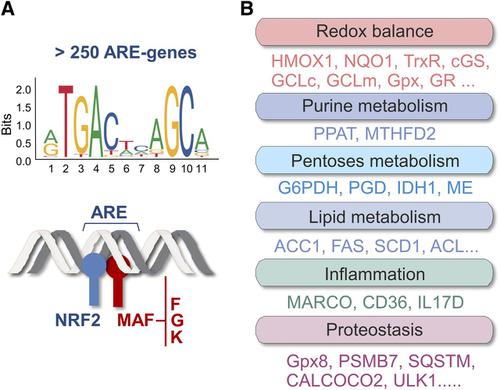当前位置:
X-MOL 学术
›
Pharmacol. Rev.
›
论文详情
Our official English website, www.x-mol.net, welcomes your
feedback! (Note: you will need to create a separate account there.)
Transcription Factor NRF2 as a Therapeutic Target for Chronic Diseases: A Systems Medicine Approach
Pharmacological Reviews ( IF 19.3 ) Pub Date : 2018-04-01 , DOI: 10.1124/pr.117.014753 Antonio Cuadrado , Gina Manda , Ahmed Hassan , María José Alcaraz , Coral Barbas , Andreas Daiber , Pietro Ghezzi , Rafael León , Manuela G. López , Baldo Oliva , Marta Pajares , Ana I. Rojo , Natalia Robledinos-Antón , Angela M. Valverde , Emre Guney , Harald H. H. W. Schmidt
Pharmacological Reviews ( IF 19.3 ) Pub Date : 2018-04-01 , DOI: 10.1124/pr.117.014753 Antonio Cuadrado , Gina Manda , Ahmed Hassan , María José Alcaraz , Coral Barbas , Andreas Daiber , Pietro Ghezzi , Rafael León , Manuela G. López , Baldo Oliva , Marta Pajares , Ana I. Rojo , Natalia Robledinos-Antón , Angela M. Valverde , Emre Guney , Harald H. H. W. Schmidt

|
Systems medicine has a mechanism-based rather than a symptom- or organ-based approach to disease and identifies therapeutic targets in a nonhypothesis-driven manner. In this work, we apply this to transcription factor nuclear factor (erythroid-derived 2)–like 2 (NRF2) by cross-validating its position in a protein–protein interaction network (the NRF2 interactome) functionally linked to cytoprotection in low-grade stress, chronic inflammation, metabolic alterations, and reactive oxygen species formation. Multiscale network analysis of these molecular profiles suggests alterations of NRF2 expression and activity as a common mechanism in a subnetwork of diseases (the NRF2 diseasome). This network joins apparently heterogeneous phenotypes such as autoimmune, respiratory, digestive, cardiovascular, metabolic, and neurodegenerative diseases, along with cancer. Importantly, this approach matches and confirms in silico several applications for NRF2-modulating drugs validated in vivo at different phases of clinical development. Pharmacologically, their profile is as diverse as electrophilic dimethyl fumarate, synthetic triterpenoids like bardoxolone methyl and sulforaphane, protein–protein or DNA–protein interaction inhibitors, and even registered drugs such as metformin and statins, which activate NRF2 and may be repurposed for indications within the NRF2 cluster of disease phenotypes. Thus, NRF2 represents one of the first targets fully embraced by classic and systems medicine approaches to facilitate both drug development and drug repurposing by focusing on a set of disease phenotypes that appear to be mechanistically linked. The resulting NRF2 drugome may therefore rapidly advance several surprising clinical options for this subset of chronic diseases.
中文翻译:

转录因子NRF2作为慢性疾病的治疗靶点:系统医学方法
系统医学采用基于机制而非基于症状或器官的方法来治疗疾病,并以非假设驱动的方式确定治疗目标。在这项工作中,我们通过交叉验证其在功能低下与细胞保护功能相关的蛋白质-蛋白质相互作用网络(NRF2相互作用组)中的位置,将其应用于转录因子核因子(类胡萝卜素2)-类似2(NRF2)。压力,慢性炎症,代谢改变和活性氧形成。对这些分子图谱的多尺度网络分析表明,NRF2表达和活性的改变是疾病子网络中常见的机制(NRF2令人不快)。该网络加入了明显异质的表型,例如自身免疫性疾病,呼吸道疾病,消化系统疾病,心血管疾病,代谢疾病和神经退行性疾病,以及癌症。重要的是,这种方法在计算机上匹配并确认了在临床开发的不同阶段在体内经过验证的NRF2调节药物的几种应用。在药理学上,它们的谱图多种多样,如亲电子的富马酸二甲酯,合成的三萜类化合物(如Bardoxolone甲基和萝卜硫烷),蛋白质-蛋白质或DNA-蛋白质相互作用抑制剂,甚至是注册的药物(如二甲双胍和他汀类),它们可以激活NRF2,并可能重新用于适应症。 NRF2簇的疾病表型。因此,NRF2代表了经典和系统医学方法完全采用的第一个目标之一,该方法通过关注似乎是机械关联的一组疾病表型来促进药物开发和药物再利用。
更新日期:2018-06-03
中文翻译:

转录因子NRF2作为慢性疾病的治疗靶点:系统医学方法
系统医学采用基于机制而非基于症状或器官的方法来治疗疾病,并以非假设驱动的方式确定治疗目标。在这项工作中,我们通过交叉验证其在功能低下与细胞保护功能相关的蛋白质-蛋白质相互作用网络(NRF2相互作用组)中的位置,将其应用于转录因子核因子(类胡萝卜素2)-类似2(NRF2)。压力,慢性炎症,代谢改变和活性氧形成。对这些分子图谱的多尺度网络分析表明,NRF2表达和活性的改变是疾病子网络中常见的机制(NRF2令人不快)。该网络加入了明显异质的表型,例如自身免疫性疾病,呼吸道疾病,消化系统疾病,心血管疾病,代谢疾病和神经退行性疾病,以及癌症。重要的是,这种方法在计算机上匹配并确认了在临床开发的不同阶段在体内经过验证的NRF2调节药物的几种应用。在药理学上,它们的谱图多种多样,如亲电子的富马酸二甲酯,合成的三萜类化合物(如Bardoxolone甲基和萝卜硫烷),蛋白质-蛋白质或DNA-蛋白质相互作用抑制剂,甚至是注册的药物(如二甲双胍和他汀类),它们可以激活NRF2,并可能重新用于适应症。 NRF2簇的疾病表型。因此,NRF2代表了经典和系统医学方法完全采用的第一个目标之一,该方法通过关注似乎是机械关联的一组疾病表型来促进药物开发和药物再利用。











































 京公网安备 11010802027423号
京公网安备 11010802027423号